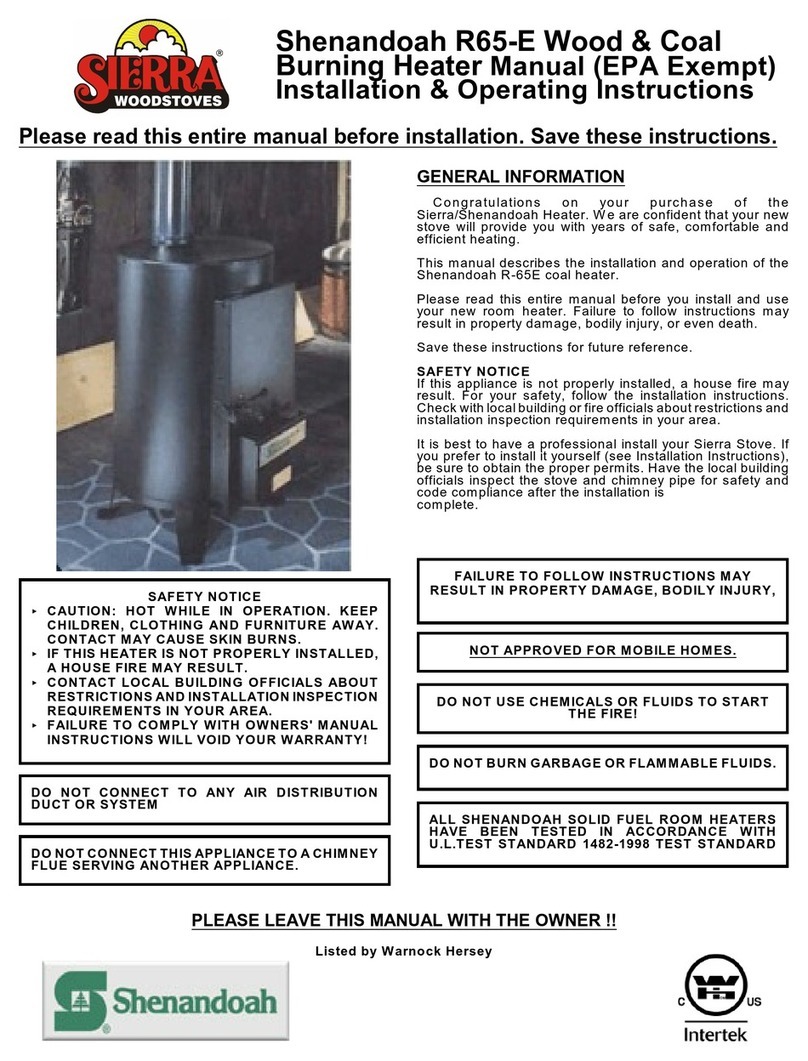
10
IV. OPERATING INSTRUCTIONS
NOTE: For the first few days, the stove will give off an odor
and a small amount of smoke. This happens when the high
temperature paint is bonding to the metal. It is normal, will
stop when the paint is cured, and will reoccur every time you
repaint or touch up the paint on your stove. Do Not use any
additional grates or support to elevate your fire.
1. Crumble three or four full sheets of newspaper and place
them on the firebrick floor of your Sierra stove.
2. Crisscross two layers of dry kindling on the paper. Add a
few larger splits of dry wood on top of the kindling.
3. Make sure the primary air control is fully open. Be certain
that the bypass level is open or up.
4. Light the paper under the kindling with a match or lighter.
Do not use gasoline, lighter fluid, charcoal starter,
kerosene or any other such fuel to start a fire in a
woodstove. You may use any type of woodstove firestarter.
See your Sierra dealer.
5. At higher altitudes, or when starting a fire on a very cold
chimney, it may be necassary to leave the door cracked
open to encourage a hot fire. Never leave your stove
unattended with the door unlatched! Never leave the
door crakced more than 5-10 minutes.
6. W hen the kindling has been consumed and larger splits
are burning well, load the stove to the level you deire, using
dry, well-seasoned wood. (W et wood does not heat well)
DO NOT BURN COAL IN THIS UNIT. Close the doors and
continue to burn the stove on high and with the
bypass open until the wood becomes fully involved.
7. Once your chimney and stove are warmed up and drawing
well, close the air inlets to the desired heat output. Reload
when convenient, but always while you still have a good
bed of coals to reload. Never close the bypass immediately
after adding fresh wood to the fire.
8. When opeing the door to reload or poke the fire, open the
bypass first. Then open the air inlet all the way for 10 to 20
seconds. Crack the door and hesitate just a few seconds
before swinging it open. All this is to prevent flashbacks
which occur when a very smoky fire suddenly is given a lot
of oxygen. If your Evolution has a tendency to spill smoke
out the side door, close the air inlet while the side door is
open.
NOTE: Every stove-chimney combination functions a little
differently. Be patient, and expect the stove to be different
in January when its cold outside, than it was in September
when it was relatively warm. Once a chimney is warmed
up, its draft is a function of how much warmer it is than the
air around it. On still mild fall evenings, stoves can appear
finicky and difficult, but the very next night, in the midst of a
fall storm, act like a completely different stove.
9. When removing ashes from the ash pan, place them in a
metal container with a tight-fitting lid. Assume that there are
still hot coals mixed in them for at lest three days. DO NOT
place them with the garbage or in the garbage or near
anything combustible. The best idea is to leave them
outside, three feet away from the house, in a metal
container, for three days.
10.If your stove has a blower, do not run the electrical cord
infront or near the fire box.
V. USING A CATALYTIC COMBUSTOR
Definition and Purpose of a Catalytic Combustor
Catalytic combustors for woodstoves (cats) are simular in
principle to catalytic converters on automobiles. The big
difference is that the heat generated by your woodstove is put
to use heating your home instead of being dumped out the
tailpipe of your car. Catalytic combusters cause wood smoke
to burn at very low temperatures, releasing enrgy that would
otherwise be lost in the form of somke. As smoke passes
through the combustor, a rare metal (Usually platinum or
palladium) coating on the cermaic base of the combustor
changes fuel molecures in the smoke so that they burn at 500
to 600 degres Fahrenheit instead of more normal 1000 to
1200 degress Fahrenheit.
In addition to making stoves burn cleaner, combustors
improve thier heating efficiency. On the average you will
receive from 30 to 50% more heat from each piece of wood,
up to 90% less cresosote, and because the cat burns most of
the smoke, 90% less air pollution than you would from
burning a comparable stove. Of course, rsults may be higher
or lower depending on operation, chimney draft, and
combustor age.
Operation - Achieving catalytic Light-Off: During each
burning cycle, the temperature within the stove should be
raised high enough to cause the catalyst to become active up
to “Light-off.” The most conveneint time to do this is during
fuel loading while warming up the wood and the chimney.
Witha new combustor, smoke temperatures between 500 and
600 degrees Fahrenheit will begin catalytic buring. (Since the
combustors sti right above a roaring fire, this is not hard toa
chieve if you follow the instructions in Starting a Fire) As a
combustor ages, its catalytic activity decreases, so an older
cat, (beyond three years old) needs more heat during the
start-up. 700 degrees will generally be sufficient for light-off
even on an old combustor.
Your Sierra Evolution has an option from the dealer, a
catalytic indicator which will take the guesswork out of
knowing when you have light-off.






























